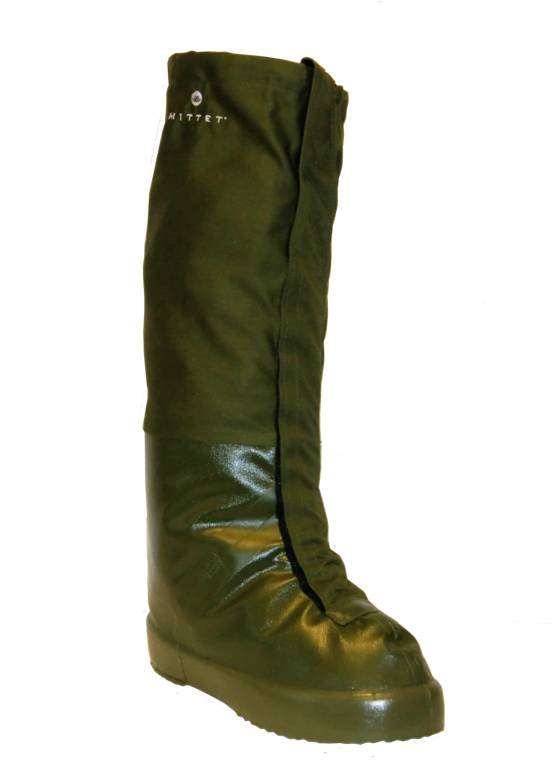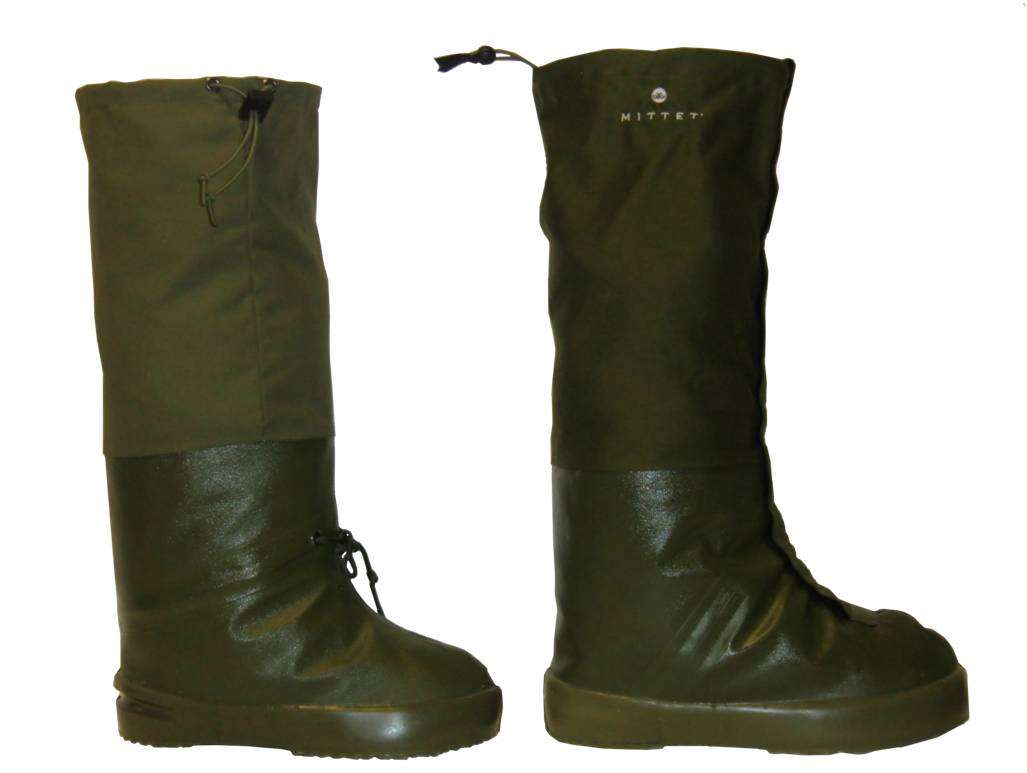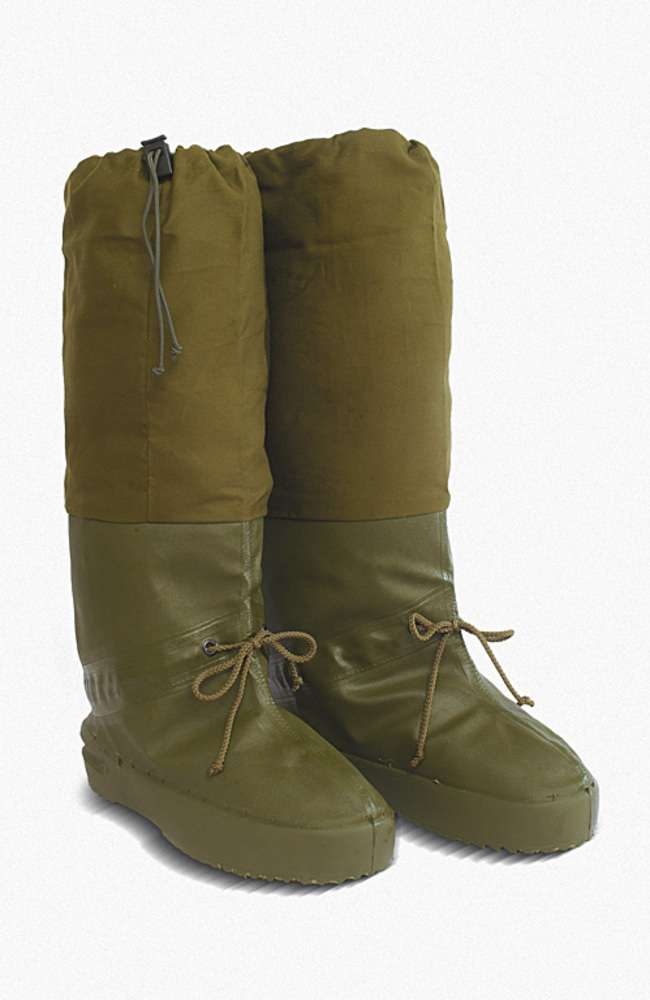Reposted from another forum
* * * * * * * *
Ok, thought I’d do a proper post of my gear, with a winter theme. This is how I am currently set up for 72 hours sustainment during winter operations. Some items have been omitted, like food and ammo, as well as comms and mission essential items. Other than those items, my gear is packed and ready in case of a short notice alert.
Hopefully you guys can pick up a thing or two from how I do things.
1st line:
Consists of a winter weight field uniform, boots, gloves and Gore-Tex hat. Over that I put on my winter overalls, and my overboots:
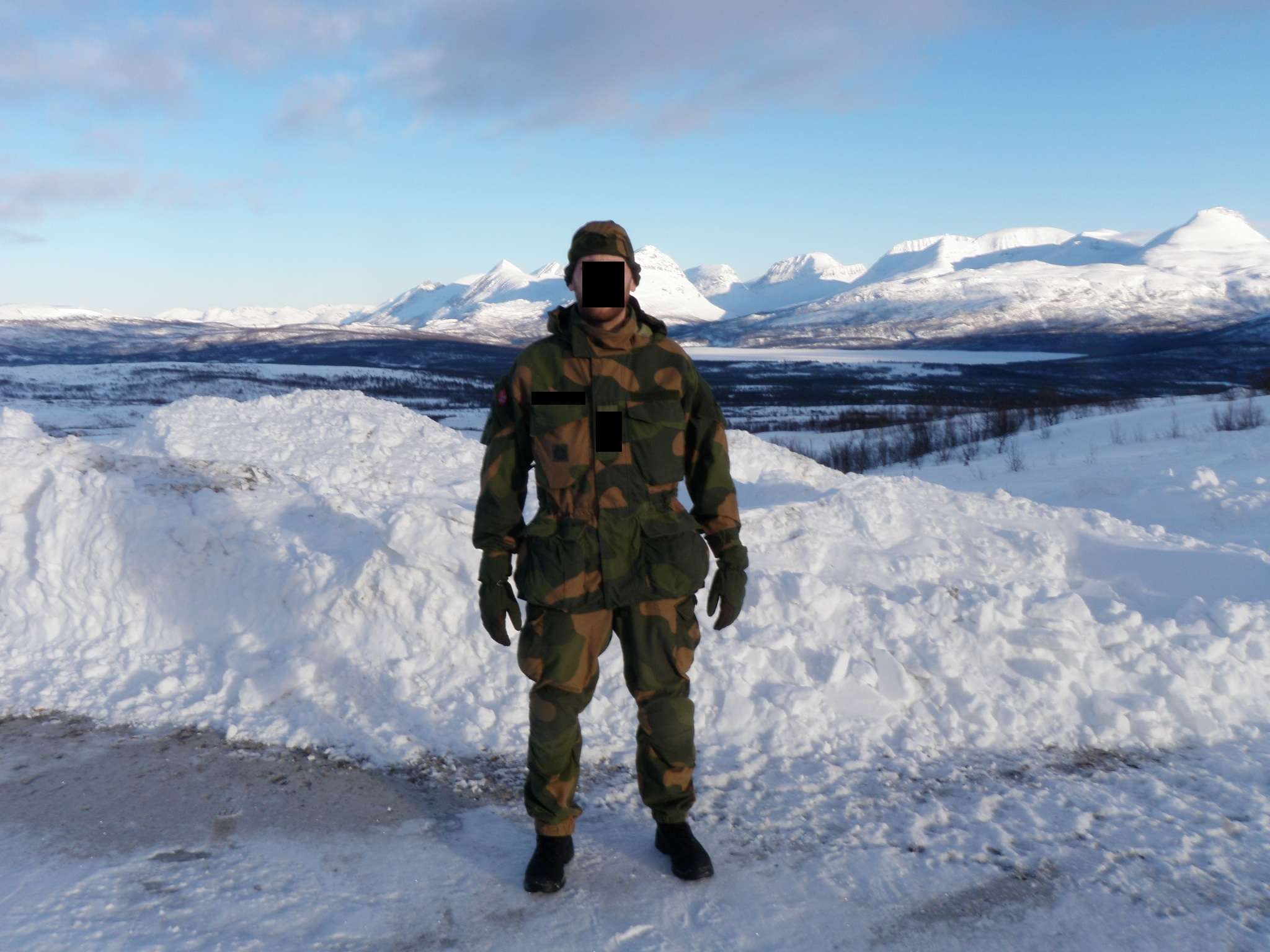

My smock:
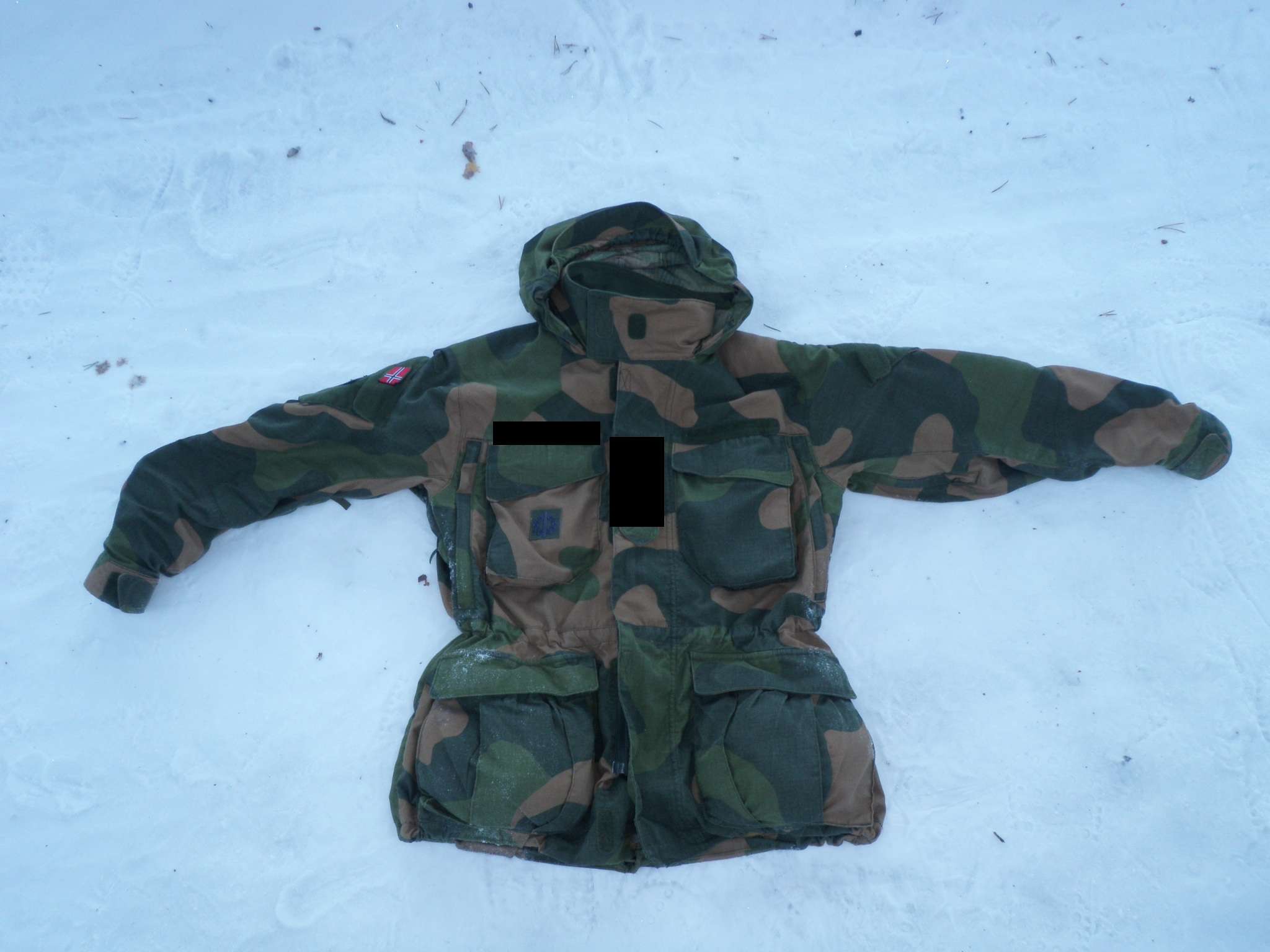
With content:
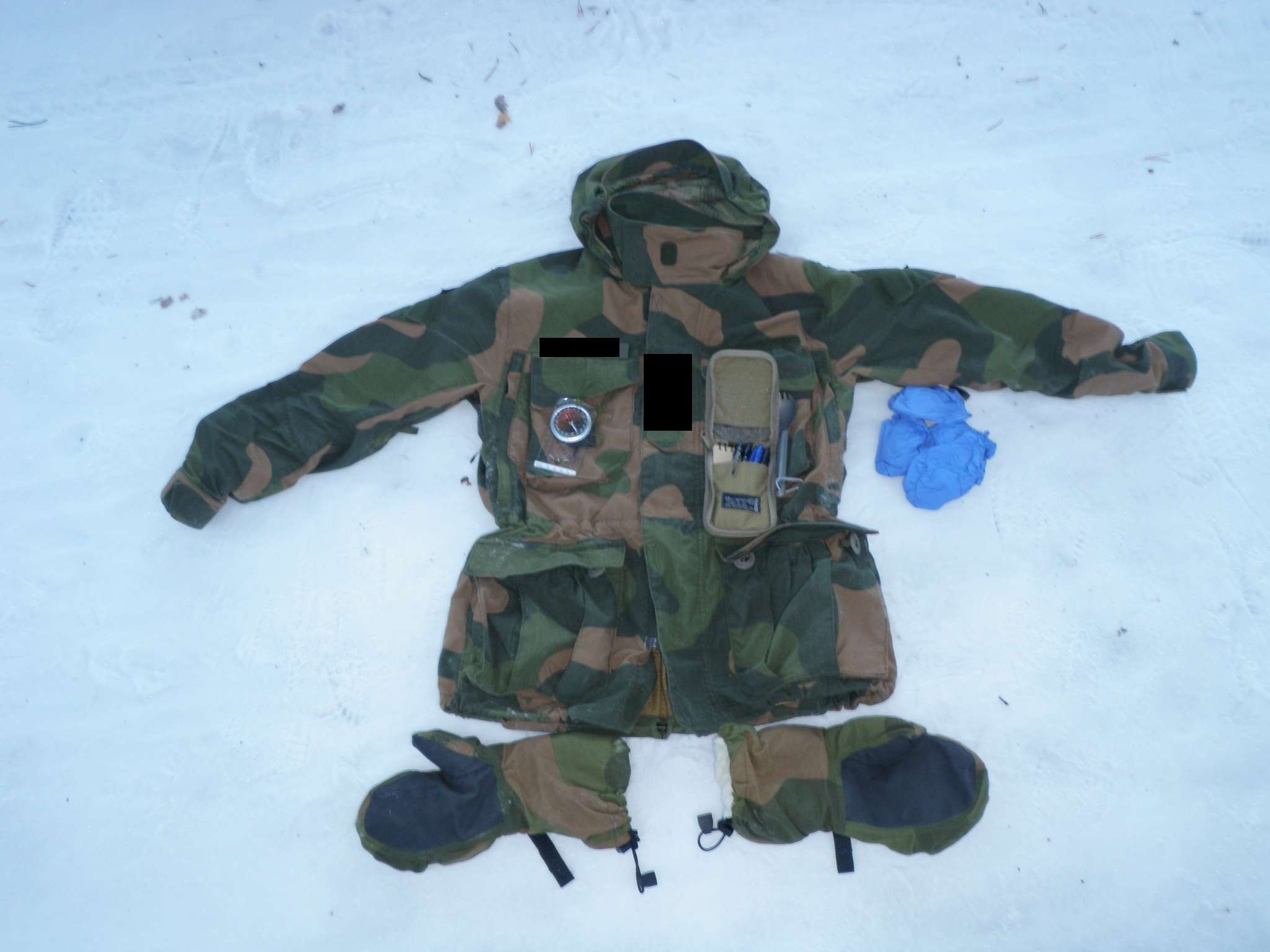
Left chest pocket: Notebook cover, notebook, pens, spork, FO protractor
Right chest pocket: Compass
Left shoulder pocket: 4 pairs disposable gloves
Left hip pocket: Left shooting mitt
Right hip pocket: Right shooting mitt
2nd line consists of the following:
HK416N:

Aimpoint Comp M4
M3X light w/tape switch
Magpul XTM hand stop kit
BFG VCAS sling (VTAC LUSA mount)
Rear BUIS (in pistol grip)
Ops Core helmet and Peltor ComTacs:
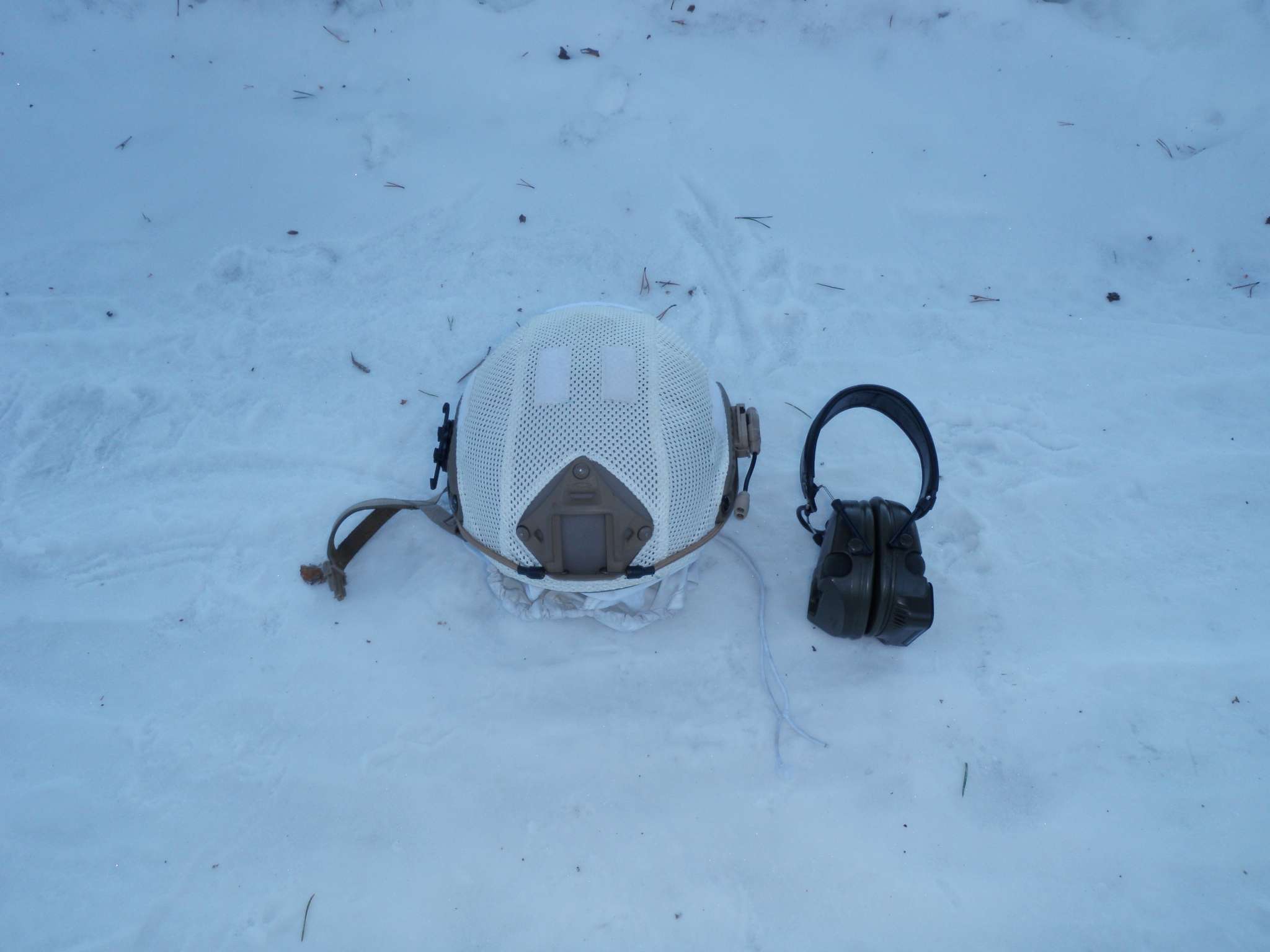
First Spear patrolling suspenders/First Spear AGB:
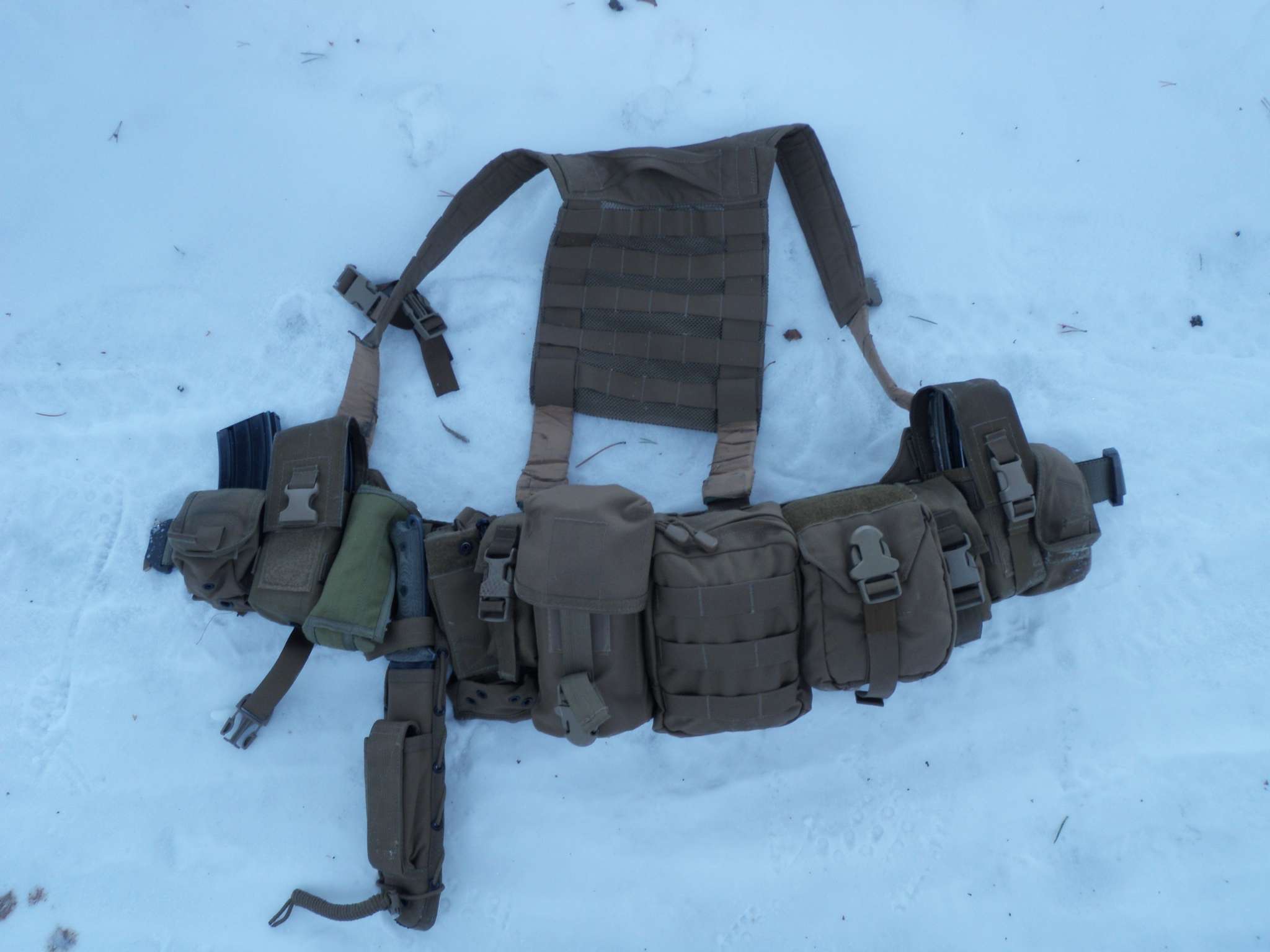
Pouches from left to right:
ATS single M4 mag pouch w/DBT frag pouch piggybacked
Specter Gear double M4 pouch
SORD dump pouch
SPEC OPS Brand Sheath
DBT MBITR pouch
MOLLE smoke grenade pouch – for TQ
TT Canteen/Utility pouch
SPEC OPS Brand Utility pouch
ATS Small Medical pouch
MOLLE smoke grenade pouch – for TQ
Specter Gear double M4 pouch
DBT smoke pouch
With content:
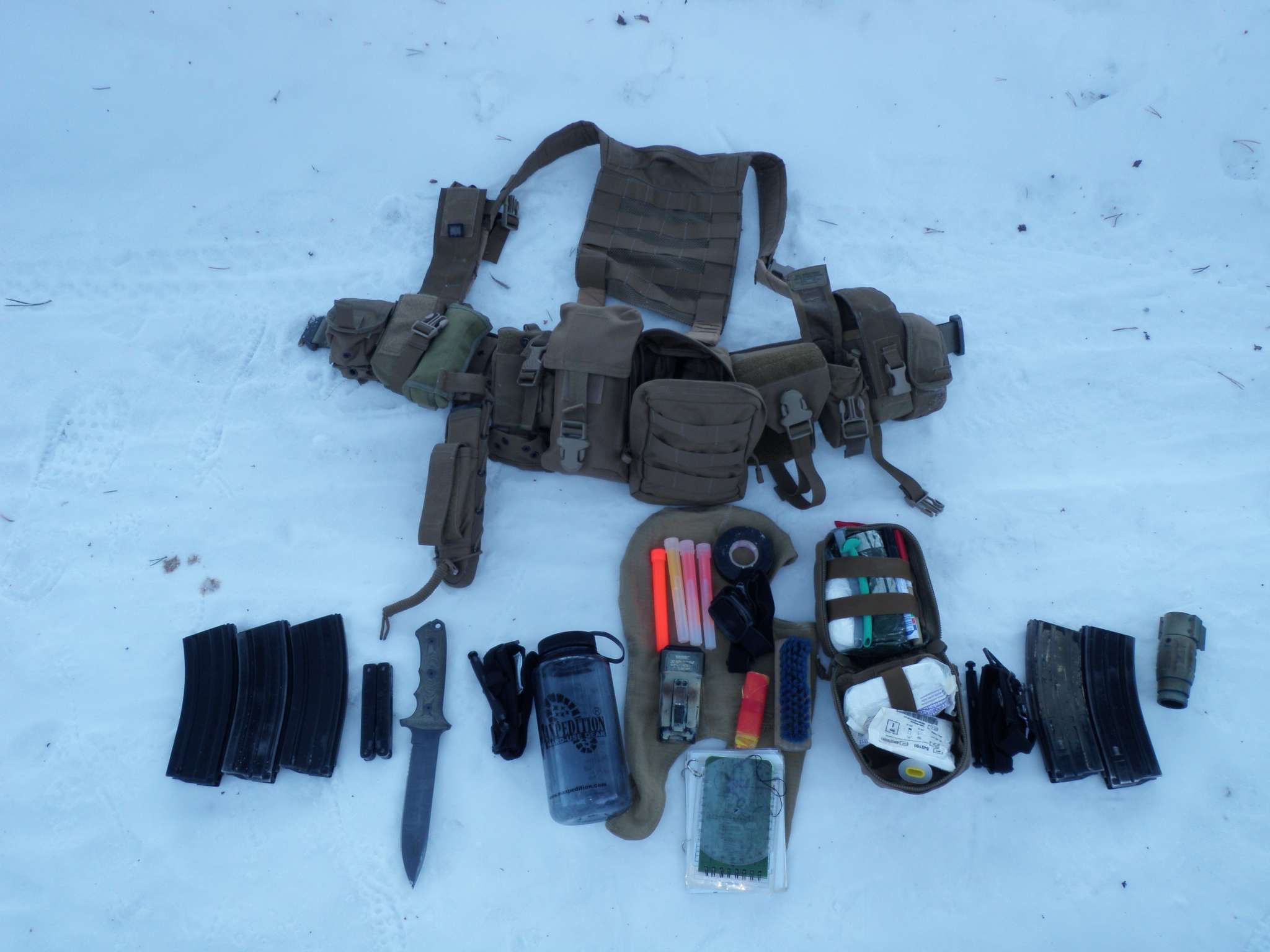
From left to right:
3 HK416 mags
Multi-Tool
Chris Reeve Yarborough knife
SOFT-T Tourniquet
Nalgene bottle
Light Sticks and MS-2000 strobe (IFF)
Petzl Head light
Electrical tape
5 m mine tape
Clothes brush
Thermal balaclava
FO Protractor
Notebook/Cheat cards/SOP folder
IFAK
SOFT-T Tourniquet
2 HK416 mags
Aimpoint 3X Magnifier
Worn, front:
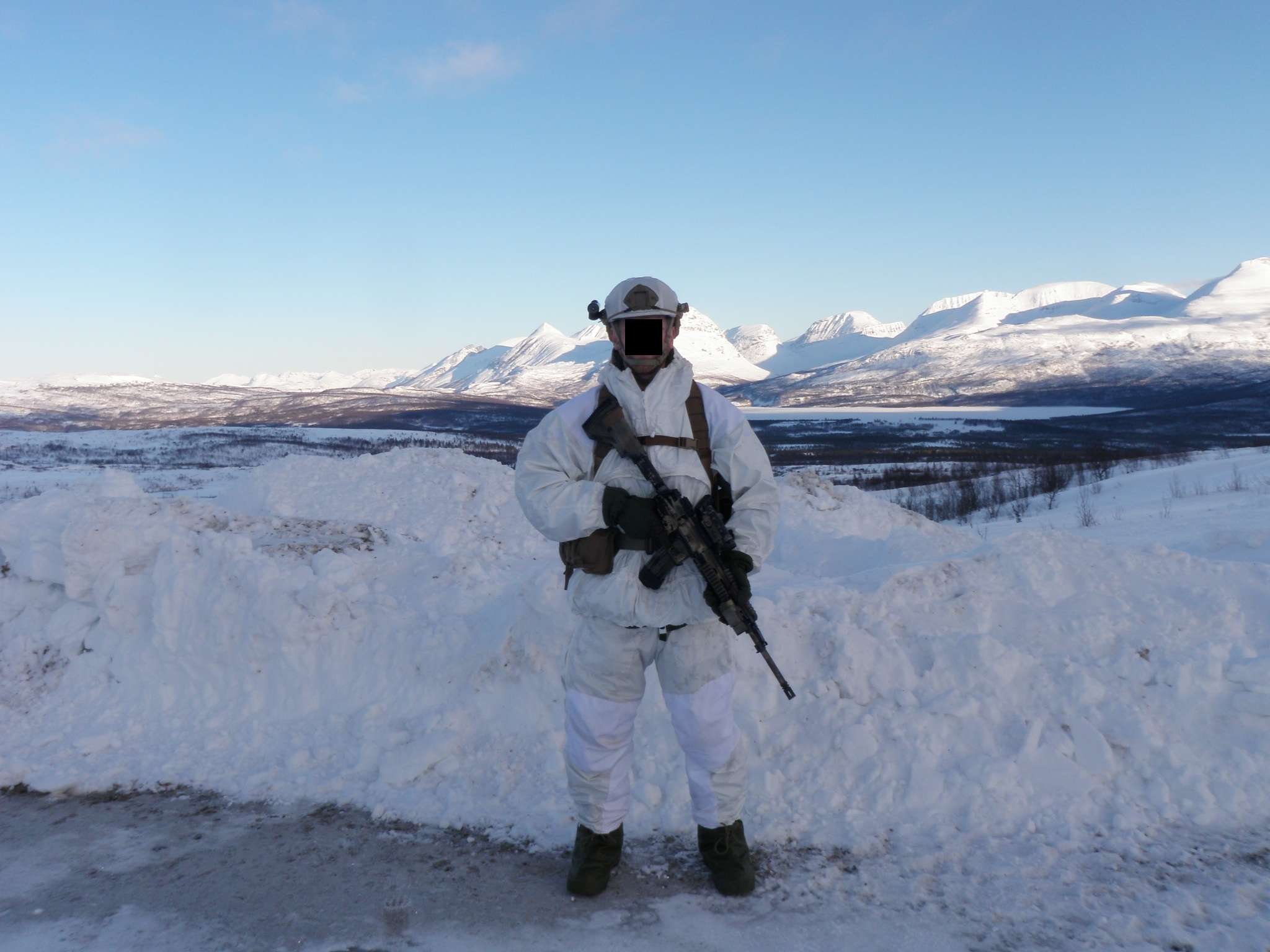
Worn, left:
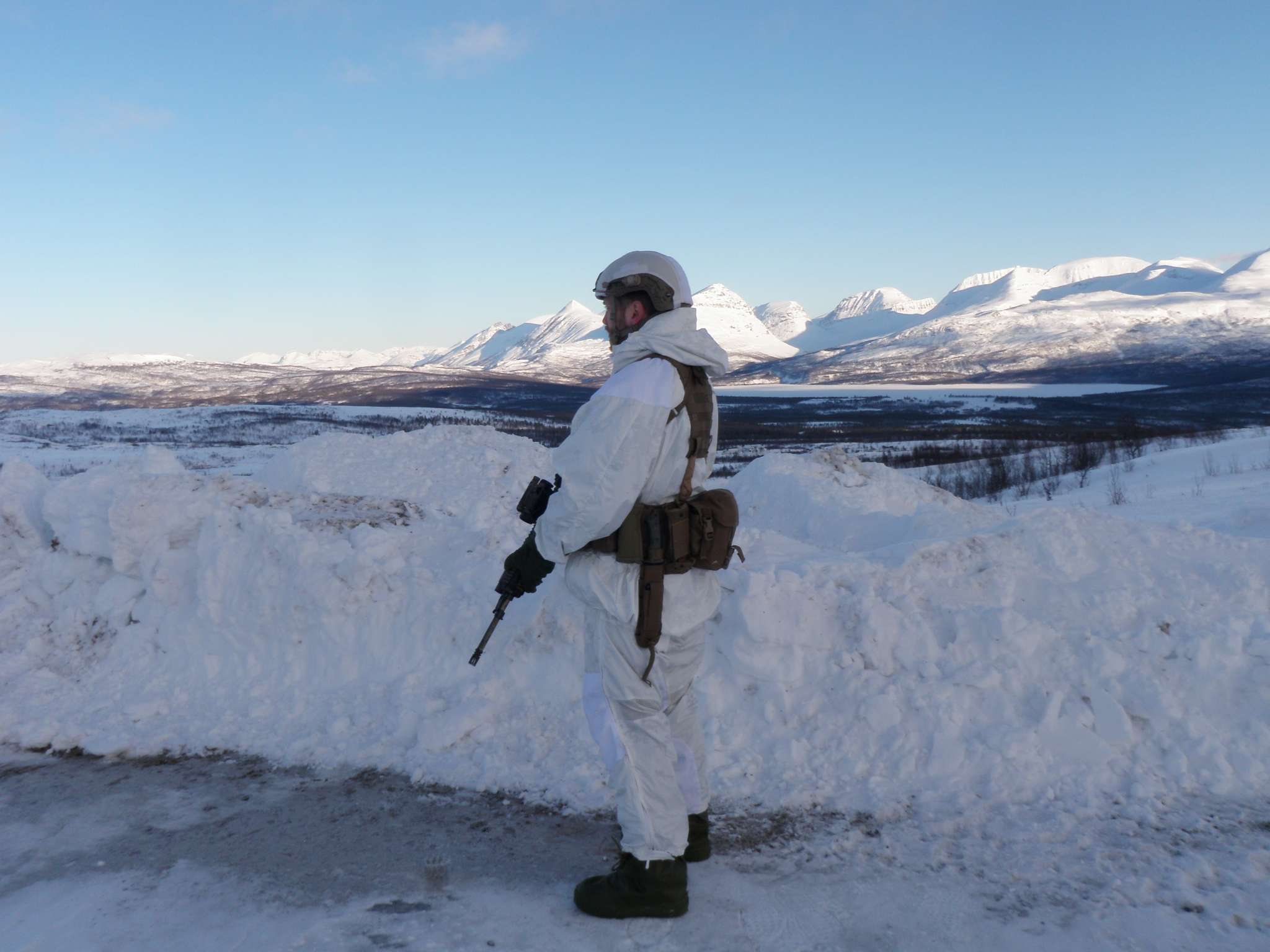
Worn, right:
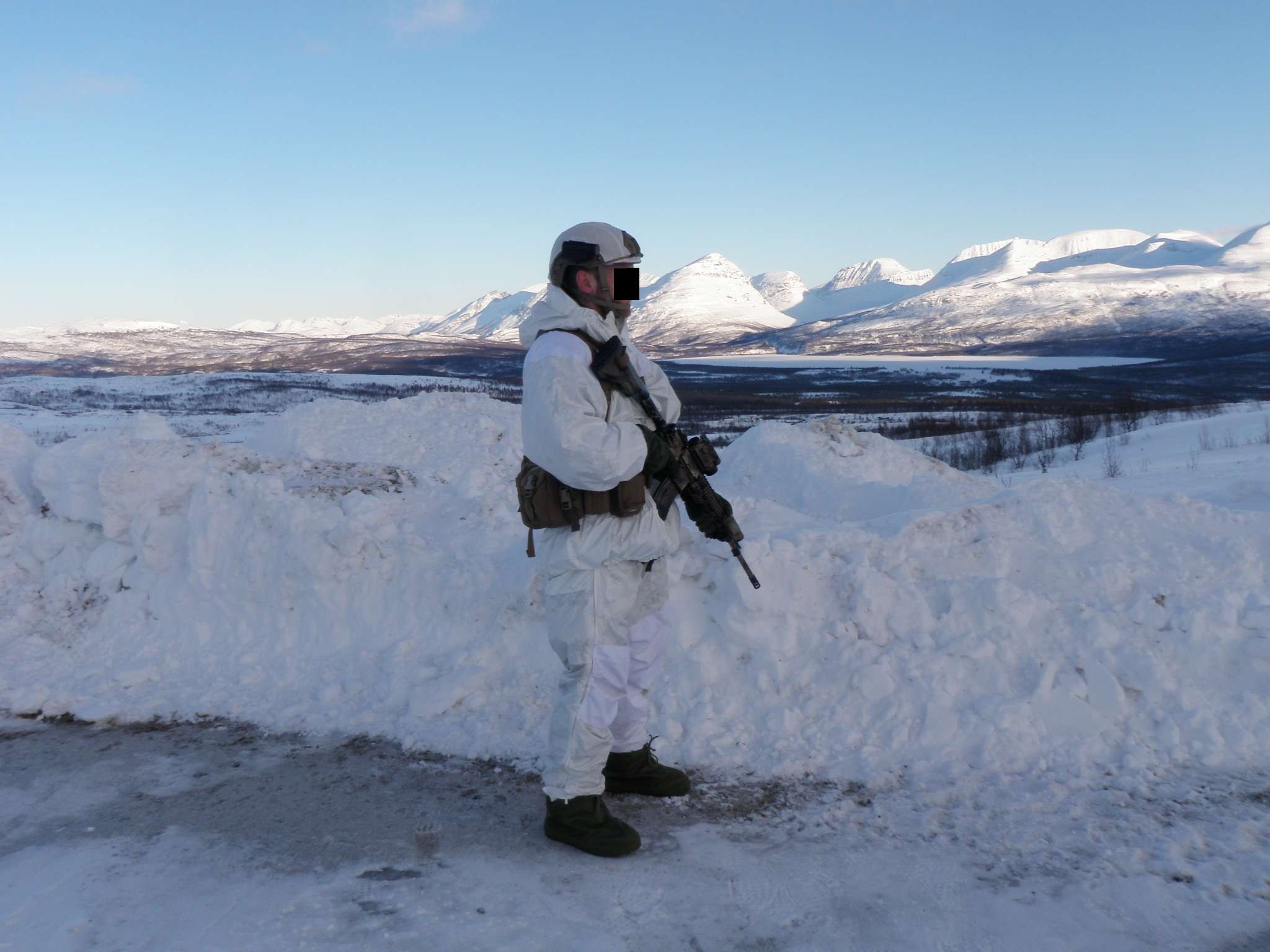
Worn, rear:
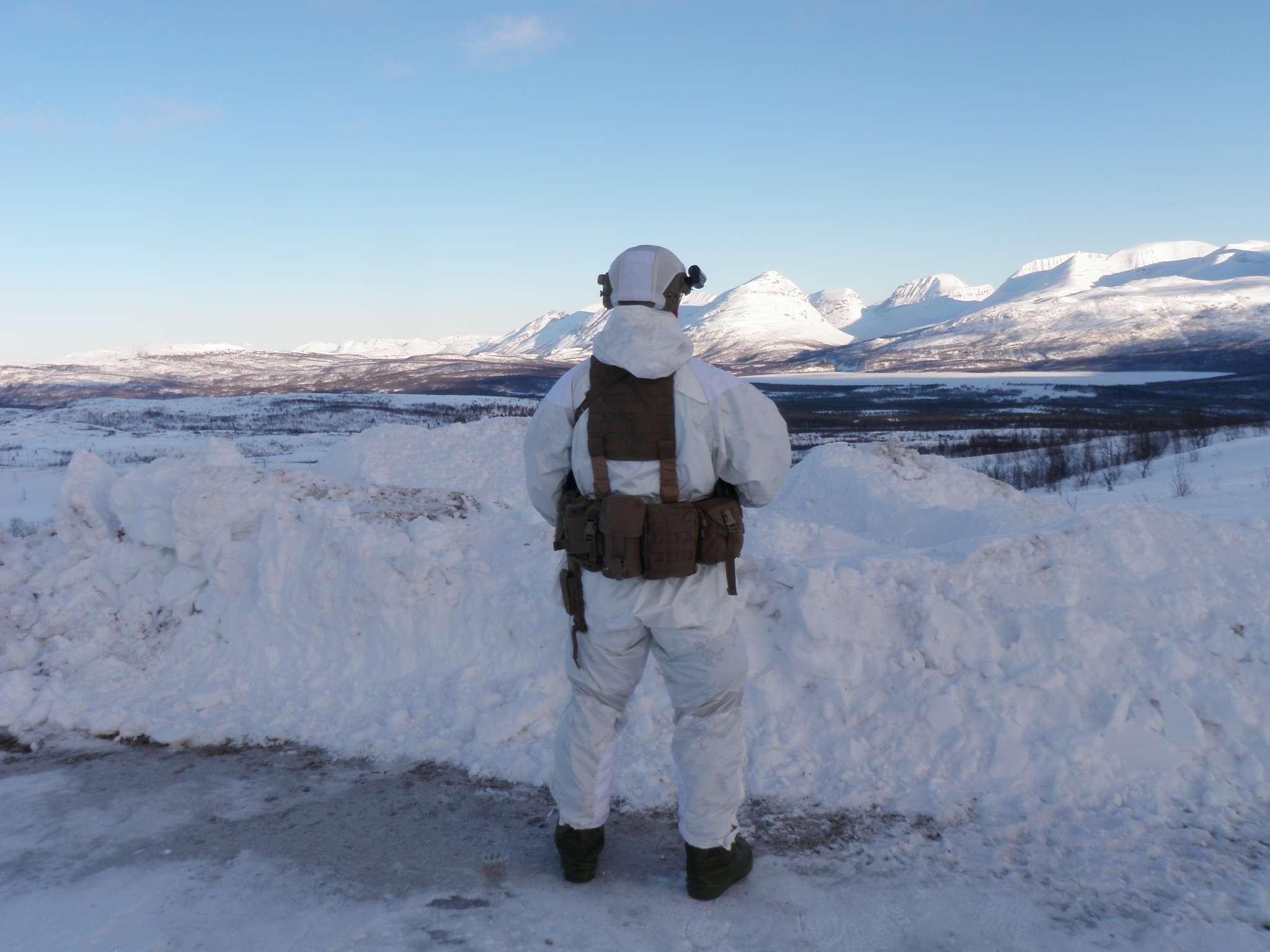
3rd line consists of the following:
Ruck; Karrimor SF TECMAC 50L with PLCE side pouches:
Front:
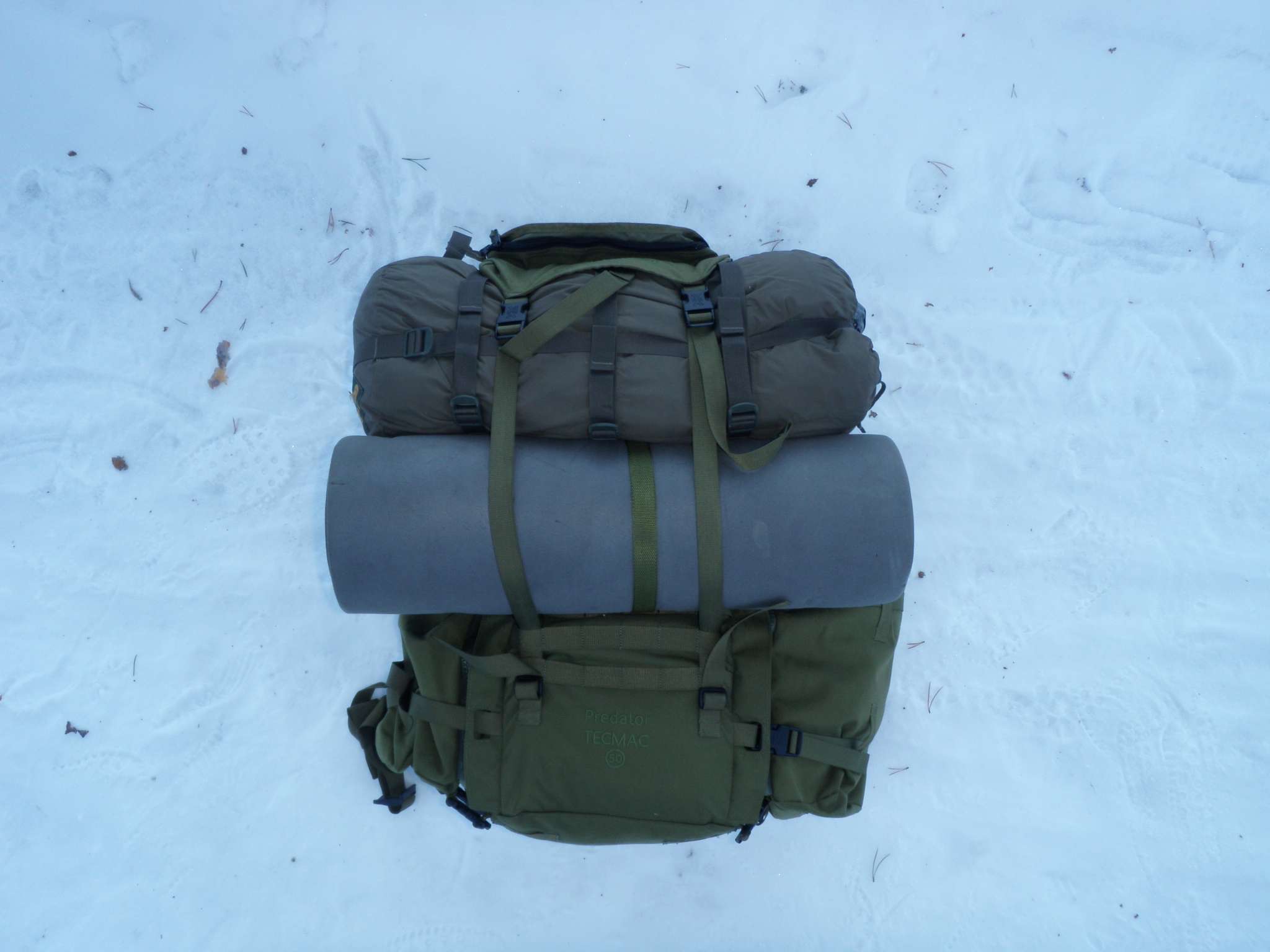
Rear:
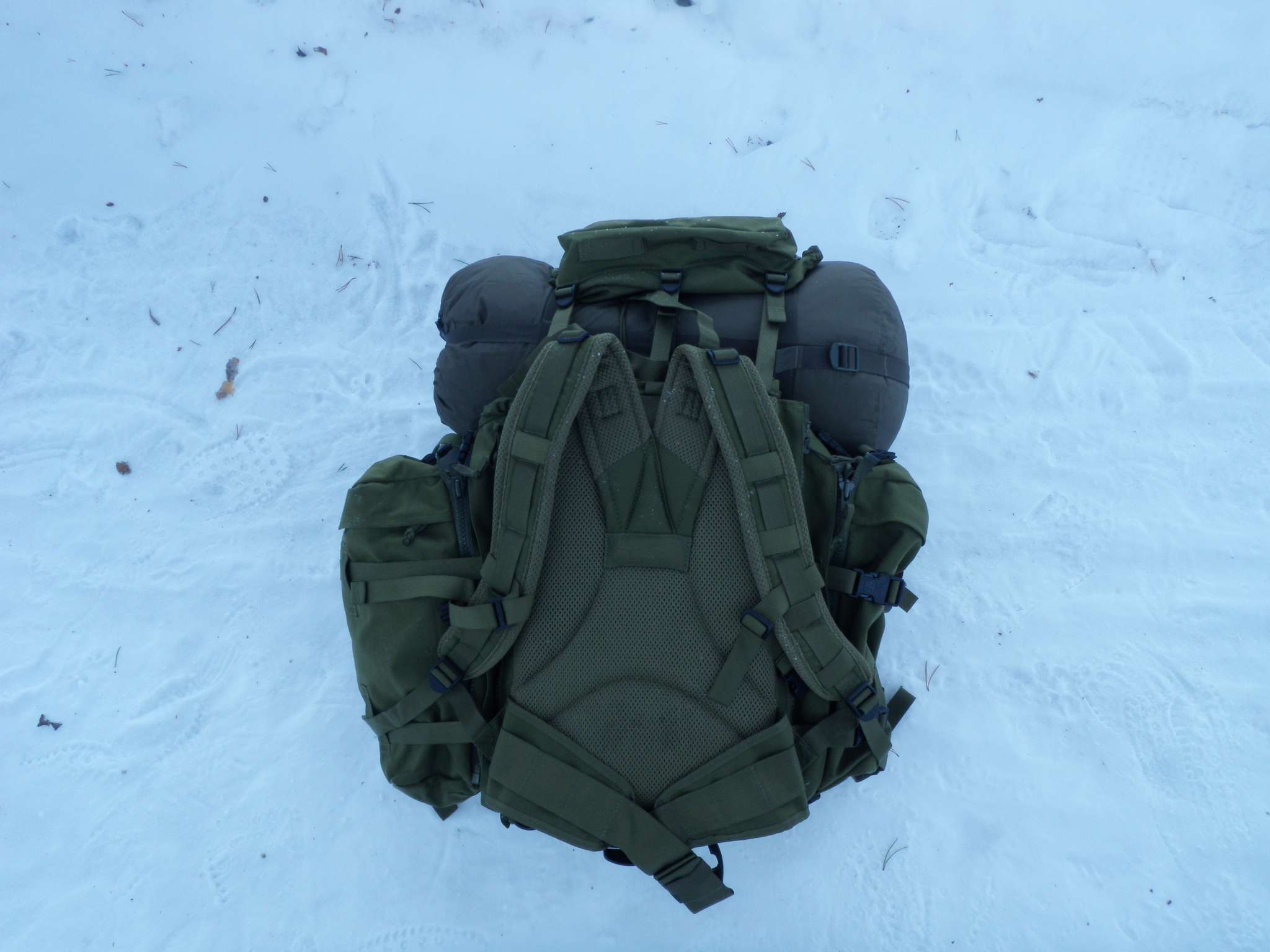
With contents:
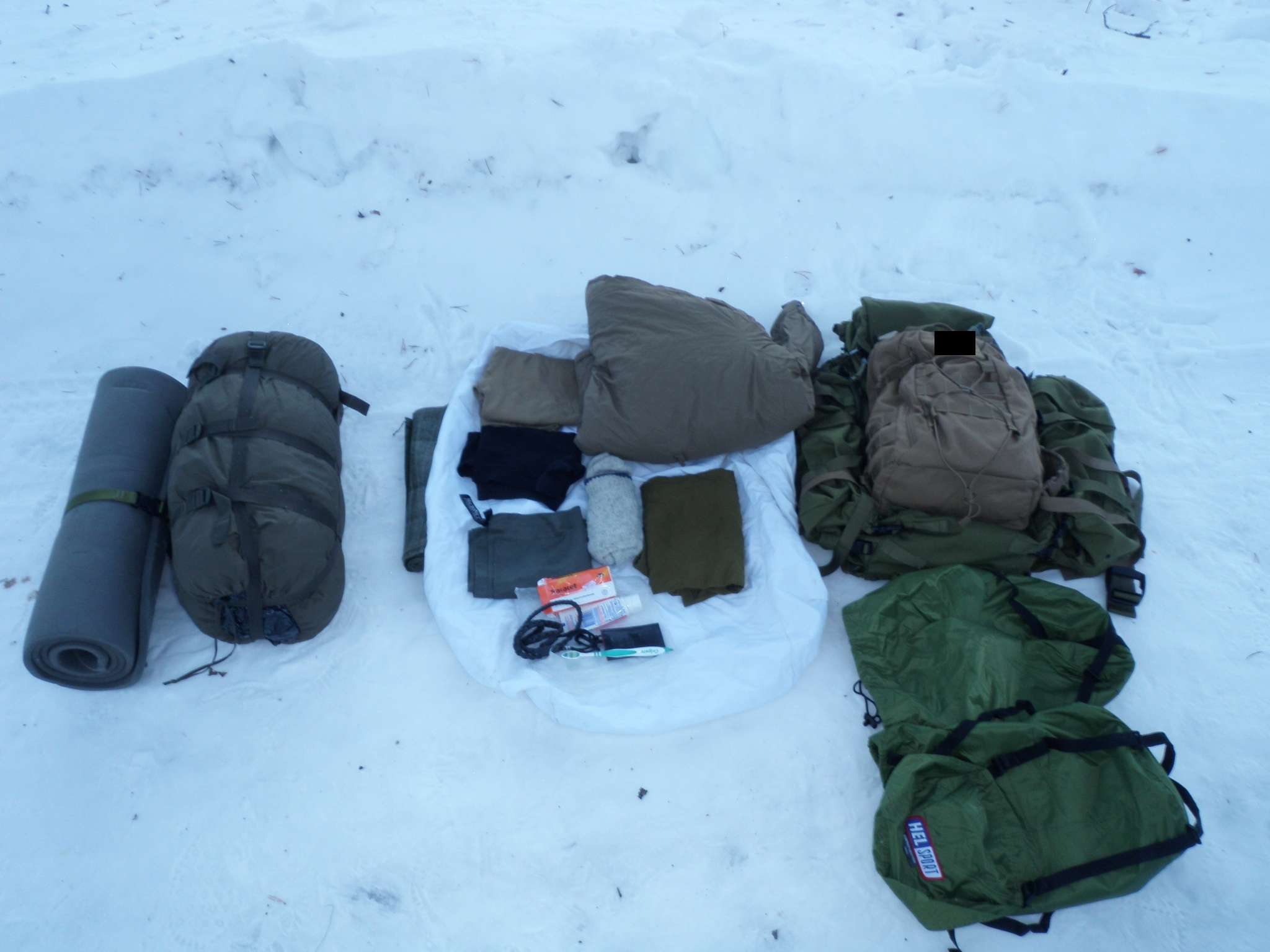
Carinthia Defense 6 sleeping bag
Ajungilak ”Bamse” sleeping mat
TT ROP assault pack
2 sandbags
2 waterproof compression sacks
Thermal Long Johns
Wool boxer
Wool socks
T-shirt
Towel
Toothbrush/Toothpaste/Painkillers/Clothesline/Sowing Kit
ECW Jacket
Assault pack contents:

2 waterproof compression sacks
2 spare magazines
Weapons cleaning kit/lens paper
Bottle of lube (Slip 2000)
Spare batteries
Hexamine cooker/matches
Para-Cord
Thermal shirt
Ruck worn front:
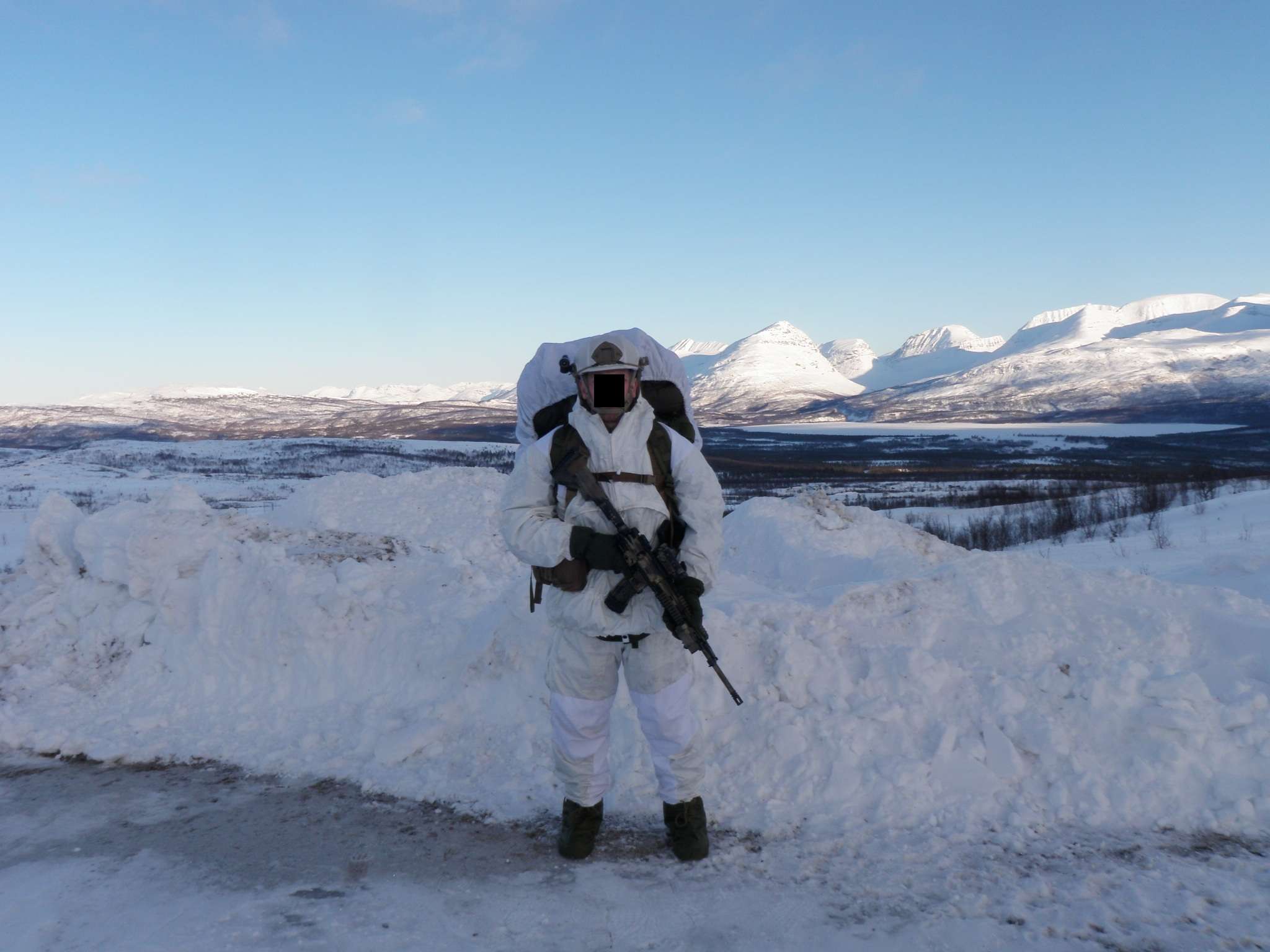
Ruck worn left:
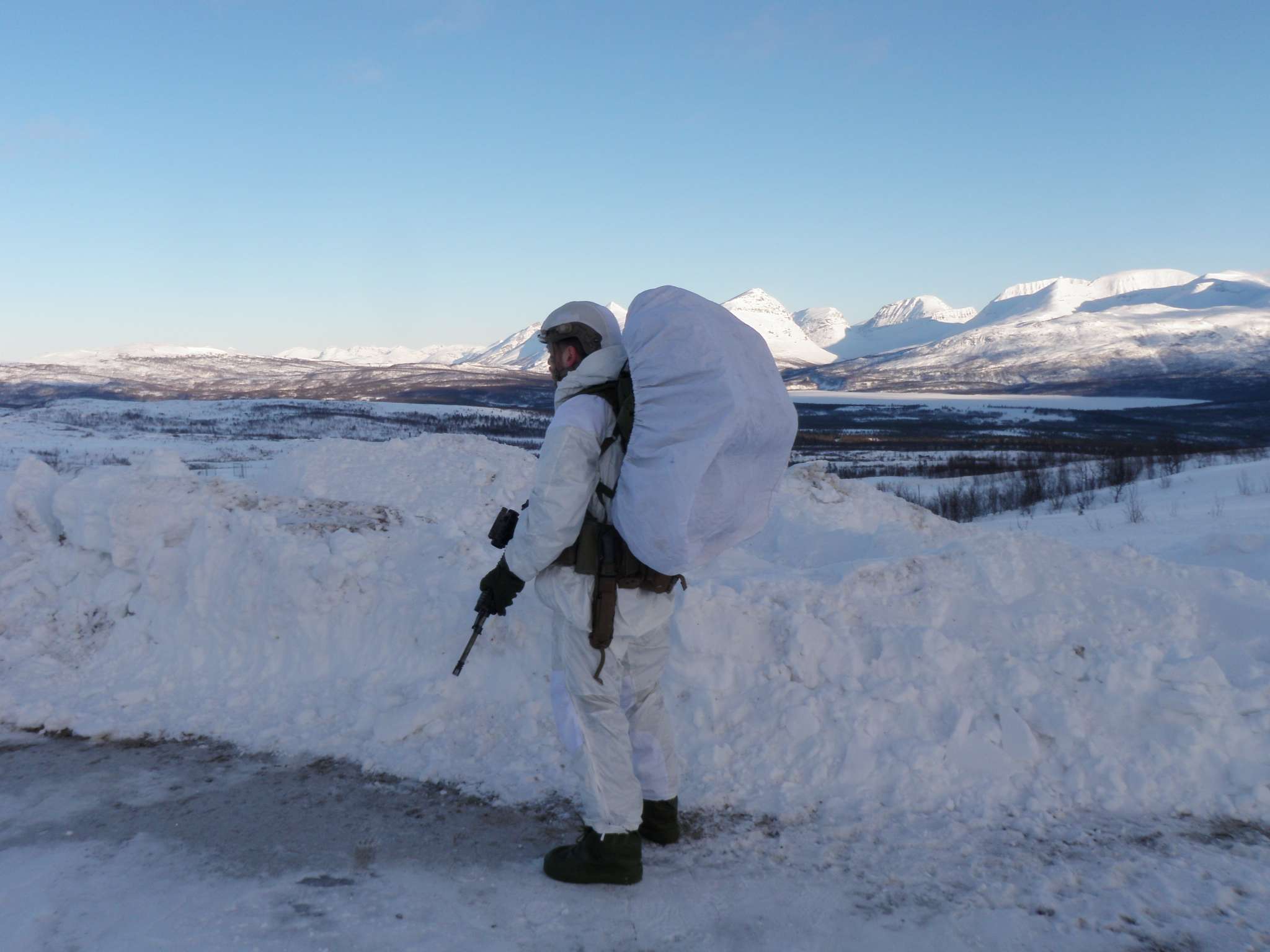
Ruck worn right:

Ruck worn rear:
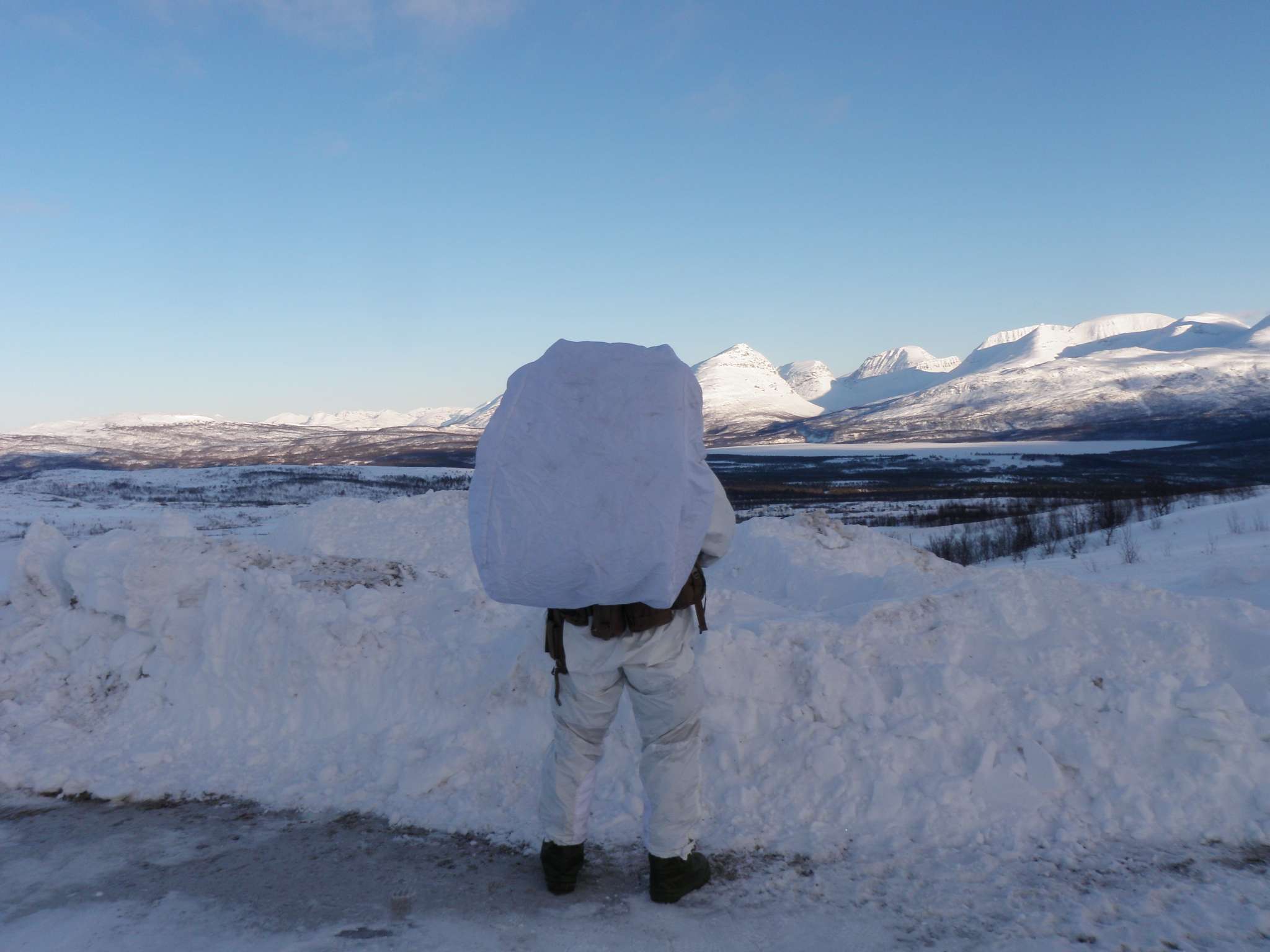
When we bivouac, we usually store our gear outside the tent or shelter, either in a ski pit or ruck pit, in order to save space inside the tent/shelter. Weapons and load bearing gear is stored on a weapons rack that is covered up, to protect the gear from the elements. This also negates any issues with temperature fluctuations and weapons freezing. All weapons field maintenance is done outside. Snow and water are the enemies of weapons during winter, so use lube to prevent water from getting into the mechanism, and use the blue clothes brush to remove snow from critical components when time avails itself. Problems arise when leaders fail to do proper checks and inspections in the field.
One key factor for success when it comes to winter survival is to never lose your gear. We never place our gloves, head gear, tools etc on the ground. If it is snowing, if it’s windy or just plain dark, your shit will be gone before you know it. Therefore I follow a very strict regimen on how I pack my gear, and I always put things back in their place when I am done using them. This allows me to find my stuff with ease, as well as making sure I don’t lose anything. This goes for all kinds of climates of course, but winter is sort of unforgiving; you lose your gloves or mitts, you will lose the ability to do simple tasks, unless you go ahead and rough it out. Big issue there is frost injuries.
When it comes to clothing, layering is the name of the game. I am probably old fashioned, but I don’t like Gore-Tex/hard shell type clothing or synthetic underwear/moisture wicking garments. My preference is for cotton based outer clothing and wool base layers. These garments, for me, breathe better, are more durable and wool has a warming effect even when moist or wet. The winter cammies are in a fire retardant, water/wind resistant, light weight fabric. It is important to be disciplined when rucking, thus it is better to remove layers and freeze a few minutes before marching than to start walking in the thermal shirt you wore to keep warm. Dehydration due to excessive sweating as well as hypothermia from wet clothes is not recommended.
Footwear for me is Alpha Omega. I have issues with iliotibialband syndrome in my right leg, so if I don’t have footwear that compensates for my over-pronation, I get issues. That said, I stay away from Gore-Tex or heavily lined boots during winter. Gore-Tex boots gets wet, never dries, and freezes and usually get very cold. Most frost injuries we see on feet are a direct result of wearing Gore-tex boots. Thin unlined leather boots, coupled with the issue over boots is the way to go. Just remember to open to over boots properly when inside to air them out, and also to remove the insoles in your boots so that any moisture trapped in the insole or underneath it also evaporates, when drying your boots.
My choice of fighting gear is based off of what enables the best individual tactics; I value being able to get comfortably into the prone position, being able to move while prone and not have pouches and mags dragging on the snow or ground. That is why I went with the patrolling suspenders/belt kit approach. I get the pouches out to the sides, and have nothing on my stomach. My critical items are easily accessible by me, non-critical items are accessible by teammates. This is also transferrable to situations where I will have to use body armor, the belt kit integrates well with BA.
The biggest minuses are of course when riding in vehicles and when wearing rucks. The belt kit is not the most comfortable kit to wear in a vehicle, but I can choose to either rough it out, or take it off while in the vehicle. It is easy to put on before we dismount. As for the ruck issue, it all comes down to choosing a ruck that rides high enough to clear the belt kit.
I chose the Tecmac 50 on a hunch, based off of a walkthrough/talk through video online by the retailer, as well as my knowledge of Karrimor quality. The issue ruck we have is too large (120L/7320 cubic inches), and I wanted a smaller ruck. I received it, and it fit my setup perfectly, it is the perfect size for what I need. It has a ton of options and possibilities:
The compression sacks in both my ruck and assault pack are used for the following reasons:
1. Easy to organize gear when packing – easy to separate different items for easy access
2. Saves space – compressed clothes take up less space
My concept for packing my ruck is based on ease of access and simplicity. The main compartment holds my assault pack and the ECW jacket (in compression sack). The right side PLCE pocket holds one compression sack containing my spare clothes; dry sleep clothing. I dry out the other garments during the night. The left PLCE pocket will hold food, extra water etc. When bivouacking, I can just unzip the side pouches, bring them inside the tent/shelter and leave the rest outside. My toiletries are kept in a zippered pouch in the lid.
If I need to escape, I will just grab my assault pack from my pack and start evading. I should be able to survive for a bit with what I have in my 1st line, 2nd line and the contents of my assault pack.
If you guys have any question, just ask and I’ll try to answer to the best of my ability.
* * * * * * * *
Ok, thought I’d do a proper post of my gear, with a winter theme. This is how I am currently set up for 72 hours sustainment during winter operations. Some items have been omitted, like food and ammo, as well as comms and mission essential items. Other than those items, my gear is packed and ready in case of a short notice alert.
Hopefully you guys can pick up a thing or two from how I do things.
1st line:
Consists of a winter weight field uniform, boots, gloves and Gore-Tex hat. Over that I put on my winter overalls, and my overboots:


My smock:

With content:

Left chest pocket: Notebook cover, notebook, pens, spork, FO protractor
Right chest pocket: Compass
Left shoulder pocket: 4 pairs disposable gloves
Left hip pocket: Left shooting mitt
Right hip pocket: Right shooting mitt
2nd line consists of the following:
HK416N:

Aimpoint Comp M4
M3X light w/tape switch
Magpul XTM hand stop kit
BFG VCAS sling (VTAC LUSA mount)
Rear BUIS (in pistol grip)
Ops Core helmet and Peltor ComTacs:

First Spear patrolling suspenders/First Spear AGB:

Pouches from left to right:
ATS single M4 mag pouch w/DBT frag pouch piggybacked
Specter Gear double M4 pouch
SORD dump pouch
SPEC OPS Brand Sheath
DBT MBITR pouch
MOLLE smoke grenade pouch – for TQ
TT Canteen/Utility pouch
SPEC OPS Brand Utility pouch
ATS Small Medical pouch
MOLLE smoke grenade pouch – for TQ
Specter Gear double M4 pouch
DBT smoke pouch
With content:

From left to right:
3 HK416 mags
Multi-Tool
Chris Reeve Yarborough knife
SOFT-T Tourniquet
Nalgene bottle
Light Sticks and MS-2000 strobe (IFF)
Petzl Head light
Electrical tape
5 m mine tape
Clothes brush
Thermal balaclava
FO Protractor
Notebook/Cheat cards/SOP folder
IFAK
SOFT-T Tourniquet
2 HK416 mags
Aimpoint 3X Magnifier
Worn, front:

Worn, left:

Worn, right:

Worn, rear:

3rd line consists of the following:
Ruck; Karrimor SF TECMAC 50L with PLCE side pouches:
Front:

Rear:

With contents:

Carinthia Defense 6 sleeping bag
Ajungilak ”Bamse” sleeping mat
TT ROP assault pack
2 sandbags
2 waterproof compression sacks
Thermal Long Johns
Wool boxer
Wool socks
T-shirt
Towel
Toothbrush/Toothpaste/Painkillers/Clothesline/Sowing Kit
ECW Jacket
Assault pack contents:

2 waterproof compression sacks
2 spare magazines
Weapons cleaning kit/lens paper
Bottle of lube (Slip 2000)
Spare batteries
Hexamine cooker/matches
Para-Cord
Thermal shirt
Ruck worn front:

Ruck worn left:

Ruck worn right:

Ruck worn rear:

When we bivouac, we usually store our gear outside the tent or shelter, either in a ski pit or ruck pit, in order to save space inside the tent/shelter. Weapons and load bearing gear is stored on a weapons rack that is covered up, to protect the gear from the elements. This also negates any issues with temperature fluctuations and weapons freezing. All weapons field maintenance is done outside. Snow and water are the enemies of weapons during winter, so use lube to prevent water from getting into the mechanism, and use the blue clothes brush to remove snow from critical components when time avails itself. Problems arise when leaders fail to do proper checks and inspections in the field.
One key factor for success when it comes to winter survival is to never lose your gear. We never place our gloves, head gear, tools etc on the ground. If it is snowing, if it’s windy or just plain dark, your shit will be gone before you know it. Therefore I follow a very strict regimen on how I pack my gear, and I always put things back in their place when I am done using them. This allows me to find my stuff with ease, as well as making sure I don’t lose anything. This goes for all kinds of climates of course, but winter is sort of unforgiving; you lose your gloves or mitts, you will lose the ability to do simple tasks, unless you go ahead and rough it out. Big issue there is frost injuries.
When it comes to clothing, layering is the name of the game. I am probably old fashioned, but I don’t like Gore-Tex/hard shell type clothing or synthetic underwear/moisture wicking garments. My preference is for cotton based outer clothing and wool base layers. These garments, for me, breathe better, are more durable and wool has a warming effect even when moist or wet. The winter cammies are in a fire retardant, water/wind resistant, light weight fabric. It is important to be disciplined when rucking, thus it is better to remove layers and freeze a few minutes before marching than to start walking in the thermal shirt you wore to keep warm. Dehydration due to excessive sweating as well as hypothermia from wet clothes is not recommended.
Footwear for me is Alpha Omega. I have issues with iliotibialband syndrome in my right leg, so if I don’t have footwear that compensates for my over-pronation, I get issues. That said, I stay away from Gore-Tex or heavily lined boots during winter. Gore-Tex boots gets wet, never dries, and freezes and usually get very cold. Most frost injuries we see on feet are a direct result of wearing Gore-tex boots. Thin unlined leather boots, coupled with the issue over boots is the way to go. Just remember to open to over boots properly when inside to air them out, and also to remove the insoles in your boots so that any moisture trapped in the insole or underneath it also evaporates, when drying your boots.
My choice of fighting gear is based off of what enables the best individual tactics; I value being able to get comfortably into the prone position, being able to move while prone and not have pouches and mags dragging on the snow or ground. That is why I went with the patrolling suspenders/belt kit approach. I get the pouches out to the sides, and have nothing on my stomach. My critical items are easily accessible by me, non-critical items are accessible by teammates. This is also transferrable to situations where I will have to use body armor, the belt kit integrates well with BA.
The biggest minuses are of course when riding in vehicles and when wearing rucks. The belt kit is not the most comfortable kit to wear in a vehicle, but I can choose to either rough it out, or take it off while in the vehicle. It is easy to put on before we dismount. As for the ruck issue, it all comes down to choosing a ruck that rides high enough to clear the belt kit.
I chose the Tecmac 50 on a hunch, based off of a walkthrough/talk through video online by the retailer, as well as my knowledge of Karrimor quality. The issue ruck we have is too large (120L/7320 cubic inches), and I wanted a smaller ruck. I received it, and it fit my setup perfectly, it is the perfect size for what I need. It has a ton of options and possibilities:
The compression sacks in both my ruck and assault pack are used for the following reasons:
1. Easy to organize gear when packing – easy to separate different items for easy access
2. Saves space – compressed clothes take up less space
My concept for packing my ruck is based on ease of access and simplicity. The main compartment holds my assault pack and the ECW jacket (in compression sack). The right side PLCE pocket holds one compression sack containing my spare clothes; dry sleep clothing. I dry out the other garments during the night. The left PLCE pocket will hold food, extra water etc. When bivouacking, I can just unzip the side pouches, bring them inside the tent/shelter and leave the rest outside. My toiletries are kept in a zippered pouch in the lid.
If I need to escape, I will just grab my assault pack from my pack and start evading. I should be able to survive for a bit with what I have in my 1st line, 2nd line and the contents of my assault pack.
If you guys have any question, just ask and I’ll try to answer to the best of my ability.










